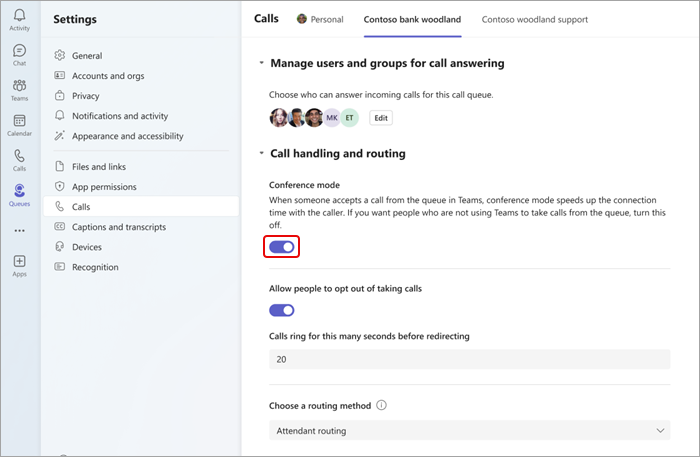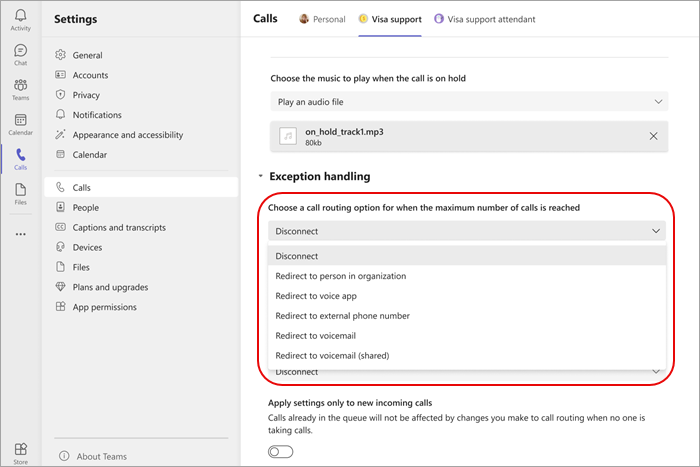Manage your call queue and auto attendant settings in Microsoft Teams
Customer facing team leads often need to make adjustments to their call queue and auto attendant settings more often than their IT admins are able to handle. Admins have the ability to delegate certain people as authorized users and give them the ability to change settings like hours of operation, call routing, queue membership, and pre-recorded greetings for their respective call queues and auto attendants without leaving Teams.
Notes:
-
To create authorized team supervisors, IT admins will first need to create a voice applications policy. To learn more, see Plan for auto attendant and Call queue authorized users.
-
The Queues app for Microsoft Teams is included in Teams Premium, an add-on license that provides additional features to make Teams meetings more personalized, intelligent, and secure. To get access to Teams Premium, contact your IT admin.
In this article
Configure call queue settings
Allow people to opt out of taking calls
Configure auto attendant settings
Configure call queue settings
Allow people to opt out of taking calls
-
Go to Settings > Calls > Call handling and routing
-
Switch Allow people to opt out of taking calls on or off depending on your needs.
Conference mode
Conference mode reduces the amount of time it takes for you to connect with a caller after you accept the call.
-
Go to Settings > Calls > Call handling and routing
-
Switch conference mode on or off depending on your needs.
Manage users and groups
Add or remove team members from call queues and Microsoft 365 Groups. You can change their order for serial call routing, which will ring each person in the order they're listed.
-
Go to Settings > Calls
-
Select the call tab you'd like to make changes to along the top of the screen.
-
Select Manage users and groups for call answering.
-
Select Edit to change who is in the call queue.
-
Select Add users and groups.
-
Add a user or group by typing their name and selecting the correct person or group from the dropdown.
-
Click and drag users or groups to rearrange your list order.
-
To remove a user or group from the list, select the trash next to their name.
Note: You can add up to 20 users to a call queue. If you need to add more users (up to 200), you must add them to a distribution list or Microsoft 365 group.
Choose a routing method
Routing methods determine the order in which agents receive calls from the queue. There are four types of routing methods:
Attendant routing rings all agents in the queue at the same time. The first agent to pick up the call gets the call.
Serial routing rings all agents one by one in the order specified in the people list. If an agent dismisses or doesn’t pick up a call, the call will ring the next agent. This cycle repeats until the call is answered, times out, or the caller hangs up.
Round robin balances the routing of incoming calls so that each agent gets the same number of calls from the queue.
Longest idle routes each call the agent who's idled the longest time. An agent is considered idle if their status shows Available. Agents who aren’t available don’t receive calls until they change their status to Available.
How to choose a routing method:
-
Go to Settings > Calls > Call handling and routing.
-
Scroll down to Choose a routing method.
-
Select your preferred routing method.
Notes:
-
When using Longest idle and when there are less calls in the queue than available agents, only the first two longest idle agents will be presented with calls from the queue.
-
When using Longest idle, there might be times when an agent receives a call from the queue shortly after becoming unavailable, or a short delay in receiving a call from the queue after becoming available.
-
Call Queue call presentation to agents may conflict with Location Based Routing restrictions. In this case, the agent will receive a call notification but can't answer the call. This condition will continue until another agent is available to answer the call, the caller hangs up, or the call queue timeout condition occurs.
Change greeting settings
-
Select Settings and more
-
Choose the call queue line you want to make changes in.
-
Select No greeting, Add a greeting message, or Play an audio file from the greeting dropdown menu.
-
If you choose Play an audio file, upload the audio file with accepted formats.
-
If you choose Add a greeting message, type a message.
-
-
Select Save.
Modify exception handling
Choose how you want to handle disconnected calls, calls that exceed the maximum wait time, and other call routing options dependent on certain circumstances.
-
Go to Settings > Calls
-
Scroll down to Exception handling
-
Choose a call routing option for when the maximum number of calls is reached. Choose from:
-
Disconnect: disconnects the call.
-
Redirect to person in organization: Direct the call to a specific person.
-
Redirect to voice app: Redirect to an auto attendant or Call queue.
-
Redirect to external phone number: Set external phone number to redirect to.
-
Redirect to voicemail: choose a personal voicemail to redirect to.
-
Redirect to voicemails (shared): choose a shared voicemail to redirect to.
Note: When redirecting calls to a person in the organization, that person must be voice enabled. For details on enabling voice, see Assign Teams add-on licenses to users.
Configure auto attendant settings
Auto attendants let people call your organization and navigate a menu system to speak to the right department, Call queue, person, or operator.
Change auto attendant greetings
-
Select Settings and more
-
Choose the auto attendant line to which you want to make changes.
-
Select No greeting, Add a greeting message, or Play an audio file from the greeting dropdown menu.
-
If Play an audio file is selected, upload the audio file with accepted formats
-
If Add a greeting message is selected, type a message.
-
-
Select Save.
Manage business hours
Identify when your call queues are open to receiving calls.
-
Go to Settings > Calls > Manage business and after hours.
-
You’ll see a list of tabs at the top of your screen. Choose the you want to manage.
-
Select Manage hours.
-
Select the scenario that best fits your business: Open same hours every day, Open different hours everyday, or Open 24 hours.
-
Using the toggles, set which days of the week your business is open or closed.
-
Select your business hours using the dropdown menus for each day.
-
To remove a time, select the trash
Manage call flow
Change the greeting and routing options for calls received during and after business hours.
Call flow during business hours:
-
Go to Settings > Calls > Call flow for business hours.
-
You’ll see a list of tabs at the top of your screen. Choose the queues tab you want to manage.
-
Choose a greeting option for business hours. Choose from: No greeting, Play an audio file, or Add a greeting message.
-
Choose a call routing option for business hours. Choose from:
-
Disconnect
-
Redirect to a person in organization: Direct the call to a specific person.
-
Redirect to voice app: Redirect to an auto attendant or Call queue.
-
Redirect to external phone number: Choose an external phone number.
-
Redirect to voicemail: Redirect to a shared voicemail.
-
Play menu options: Choose a greeting option for menu options. For more information, see Set up Auto attendants: Play menu options.
-

Call flow after business hours
-
Go to Settings > Calls > Call flow for after hours.
-
Choose a greeting option for after hours.
-
Choose a call routing option for after hours.
Call flow for holidays
-
Go to Settings > Calls > Call flow for after hours > Manage holidays call flow
-
Edit the observed holidays for your organization by selecting Edit next to each listed holiday.
-
Choose a greeting option for each holiday.
-
Choose a call routing option for each holiday.
Note: Team members won’t be able to change the dates of a holiday unless they are authorized to make changes to every auto attendant that references the holiday schedule.





















